Performance Optimization and Economic Evaluation of CO2 Heat Pump Heating System Coupled with Thermal Energy Storage
Abstract
:1. Introduction
2. System Description
3. Model and Boundary Conditions
3.1. Building Model
3.2. Mathematical Model of CO2 ASHP
3.3. TES Model
3.4. Other Components Mode and System Control Strategy
4. Results and Discussion
4.1. Effect of PCMs Weight on the System Characteristics
4.2. Effect of Phase Change Temperature of PCM on the System Characteristics
4.3. Effect of Water Tank Volume on the System Characteristics
4.4. System Optimization
4.4.1. Optimization Algorithm Parameter Settings
4.4.2. Optimization Results
5. Conclusions
Author Contributions
Funding
Institutional Review Board Statement
Informed Consent Statement
Data Availability Statement
Conflicts of Interest
Nomenclature
| A | Heat exchange area, (m2); |
| Heat exchange area of inner tube, (m2); | |
| Maximum area of PCM, (m2); | |
| Outer surface area of inner tube, (m2); | |
| Initial investment of the system, (RMB); | |
| Specific heat capacity of water at constant pressure, (kJ/(kg·°C)); | |
| CD | Waste disposal costs, (RMB); |
| CI | Initial investment of the system, (RMB); |
| CO | Operation and maintenance costs, (RMB); |
| Corrected COP of ASHP; | |
| Coefficient of performance of ASHP; | |
| The COP under the rated conditions | |
| Micro segment length, (m); | |
| Corrected heating capacity of ASHP, (kW); | |
| Heating capacity of ASHP, (kW); | |
| Heating capacity of ASHP under the rated condition (kW); | |
| R | Changing radius of the PCM during phase change, (m); |
| RHTF | Heat transfer resistance between thermal fluid and wall, (m2·K·W−1); |
| Rmax | Radius of PCM when point of intersection with neighboring phase change front, (m); |
| RPCM | Heat transfer resistance between PCM (m2 ·K·W−1) |
| Total heat resistance of heat exchanger, (K/W); | |
| RWALL | Heat conduction resistance of tube wall (K/W); |
| Inner radius of casing, (m); | |
| Outer radius of casing, (m); | |
| S | Shape coefficient of phase change material in heat exchanger; |
| Simulation value of heat exchange outlet water temperature, (°C); | |
| Experimental value of heat exchange outlet water temperature, (°C); | |
| Volume of water tank, (m3); | |
| Water storage tank volume, (m3); | |
| Energy consumption of water pump, ([kW); | |
| Energy consumption of auxiliary electric heating of the system, (kW); | |
| Energy power consumption of the CO2 ASHP, (kW); | |
| Inner diameter of inner tube of heat exchanger, (m); | |
| Heat transfer coefficient between heat source fluid and inner wall of heat exchanger, (W·m−2); | |
| The bench discount rate, (%); | |
| The average annual increase rate of electricity bills; | |
| k | Overall heat-transfer coefficient, (W/(m2·K)); |
| Flow rate of heat exchange fluid, (kg·s−1); | |
| n | n = 0.4 for heating; |
| Mass of PCM, (kg); | |
| Time, (s); | |
| Outdoor dry bulb temperature, (°C); | |
| Inlet water temperature of gas cooler, (°C); | |
| Thermal conductivity of fluid, (W·(m·K)−1); | |
| Wall thermal conductivity, (W·m−1); | |
| PCM thermal conductivity, (W·m−1); | |
| Hydrodynamic viscosity, (kg·(m·s)−1); | |
| Nusselt number; | |
| ASHP | Air source heat pump |
| EC | The electricity cost |
| EEV | Electronic expansion valves |
| GWP | Global warming potential |
| HRM | Heat release mode |
| HSM | Heat storage mode |
| IHX | Internal heat exchange |
| LC | The labor cost |
| LCC | Life cycle cost |
| NTU | Number of transfer units |
| OTC | The annual operating cost |
| ODP | Ozone depletion potential |
| P2 | The water pump |
| PCM | Phase change material |
| RC | The maintenance cost |
| TES | Thermal energy storage |
| Subscript | |
| Sys | System |
References
- Sartori, T.; Calmon, J.L. Analysis of the impacts of retrofit actions on the life cycle energy consumption of typical neighbourhood dwellings. J. Build. Eng. 2019, 21, 158–172. [Google Scholar] [CrossRef]
- Song, M.; Mao, N.; Xu, Y.; Deng, S. Challenges in, and the development of, building energy saving techniques, illustrated with the example of an air source heat pump. Therm. Sci. Eng. Prog. 2019, 10, 337–356. [Google Scholar] [CrossRef]
- Song, M.; Xie, G.; Pekař, L.; Mao, N.; Qu, M. A modeling study on the revere cycle defrosting of an air source heat pump with the melted frost downwards flowing away and local drainage. Energy Build. 2020, 226, 110257. [Google Scholar] [CrossRef]
- Li, Y.; Rezgui, Y.; Zhu, H. District heating and cooling optimization and enhancement—Towards integration of renewables, storage and smart grid. Renew. Sustain. Energy Rev. 2017, 72, 281–294. [Google Scholar] [CrossRef]
- Zhang, L.; Jiang, Y.; Dong, J.; Yao, Y. Advances in vapor compression air source heat pump system in cold regions: A review. Renew. Sustain. Energy Rev. 2018, 81, 353–365. [Google Scholar] [CrossRef]
- Wang, Z.; Zhang, Y.; Wang, F.; Li, G. Research on the characteristics of CO2 heat pump integrated with thermal energy storage for space heating. J. Mech. Sci. Technol. 2021, 35, 2259–2270. [Google Scholar] [CrossRef]
- Ma, R.; Mao, C.; Shan, M.; Zhang, L.; Yang, X. Occupant control patterns of low temperature air-to-air heat pumps in Chinese rural households based on field measurements. Energy Build. 2017, 154, 157–165. [Google Scholar] [CrossRef]
- Wang, Z.; Li, G.; Wang, F. Techno-economic evaluation of a frost-free air source heat pump water heater. Sustain. Cities Soc. 2020, 57, 102102. [Google Scholar] [CrossRef]
- Wang, Z.; Li, G.; Wang, F.; Liu, Z.; Wang, M. Performance analysis and operation optimization of air-to-water CO2 heat pump with phase change thermal storage. Energy Build. 2020, 209, 109738. [Google Scholar] [CrossRef]
- Song, M.; Dang, C. Review on the measurement and calculation of frost characteristics. Int. J. Heat Mass Transf. 2018, 124, 586–614. [Google Scholar] [CrossRef]
- Song, M.; Mao, N. Experimental study on the melted frost influence on the metal energy storage during an air source heat pump defrosting. Energy Build. 2020, 214, 109809. [Google Scholar] [CrossRef]
- Ma, Y.; Liu, Z.; Tian, H. A review of transcritical carbon dioxide heat pump and refrigeration cycles. Energy 2013, 55, 156–172. [Google Scholar] [CrossRef]
- ASHRAE. 15 & 34 Safety Standard for Refrigeration Systems and Designation and Classification of Refrigerants ISO 5149 Mechanical Refrigerating Systems Used for Cooling and Heating—Safety Requirements. Available online: https://www.ashrae.org/technical-resources/bookstore/standards-15-34 (accessed on 17 October 2018).
- Wang, Z.; Li, G.; Wang, F.; Zhang, Y. Performance investigation of a transcritical CO2 heat pump combined with the terminal of radiator and floor radiant coil for space heating in different climates, China. J. Build. Eng. 2021, 44, 102927. [Google Scholar] [CrossRef]
- Kim, M.-H.; Pettersen, J.; Bullard, C.W. Fundamental process and system design issues in CO2 vapor compression systems. Prog. Energy Combust. Sci. 2004, 30, 119–174. [Google Scholar] [CrossRef]
- Yu, B.; Yang, J.; Wang, D.; Shi, J.; Chen, J. An updated review of recent advances on modified technologies in transcritical CO2 refrigeration cycle. Energy 2019, 189, 116147. [Google Scholar] [CrossRef]
- Lorentzen, G. Trans-Critical Vapour Compression Cycle Device. Patent WO/ 07683, 12 July 1990. [Google Scholar]
- Riffat, S.B.; Afonso, C.F.; Oliveira, A.C.; Reay, D.A. Natural refrigerants for refrigeration and air-conditioning systems. Appl. Therm. Eng. 1997, 17, 33–42. [Google Scholar] [CrossRef]
- Yang, D.; Song, Y.; Cao, F.; Jin, L.; Wang, X. Theoretical and experimental investigation of a combined R134a and transcritical CO2 heat pump for space heating. Int. J. Refrig. 2016, 72, 156–170. [Google Scholar] [CrossRef]
- Austin, B.T.; Sumathy, K. Transcritical carbon dioxide heat pump systems: A review. Renew. Sustain. Energy Rev. 2011, 15, 4013–4029. [Google Scholar] [CrossRef]
- Jiang, Y.; Ma, Y.; Li, M.; Fu, L. An experimental study of trans-critical CO2 water–water heat pump using compact tube-in-tube heat exchangers. Energy Convers. Manag. 2013, 76, 92–100. [Google Scholar] [CrossRef]
- Qin, X.; Wang, D.; Jin, Z.; Wang, J.; Zhang, G.; Li, H. A comprehensive investigation on the effect of internal heat exchanger based on a novel evaluation method in the transcritical CO2 heat pump system. Renew. Energy 2021, 178, 574–586. [Google Scholar] [CrossRef]
- Salajeghe, M.; Ameri, M. Effects of further cooling the gas cooler outlet refrigerant by an absorption chiller, on a transcritical CO2-compression refrigeration system. Int. J. Exergy 2016, 21, 110–125. [Google Scholar] [CrossRef]
- Yu, B.; Yang, J.; Wang, D.; Shi, J.; Chen, J. Performance Enhancement Research of a CO2 Air Conditioning System with Propane Mechanical Subcooling for Electric Vehicle. Trans. Jpn. Soc. Refrig. Air Cond. Eng. 2018, 35, 409. [Google Scholar]
- Boccardi, G.; Botticella, F.; Lillo, G.; Mastrullo, R.; Mauro, A.W.; Trinchieri, R. Thermodynamic Analysis of a Multi-Ejector, CO2, Air-To-Water Heat Pump System. Energy Procedia 2016, 101, 846–853. [Google Scholar] [CrossRef]
- Bai, T.; Yan, G.; Yu, J. Performance evolution on a dual-temperature CO2 transcritical refrigeration cycle with two cascade ejectors. Appl. Therm. Eng. 2017, 120, 26–35. [Google Scholar] [CrossRef]
- Li, D.; Baek, J.S.; Groll, E.A.; Lawless, P.B. Thermodynamic analysis of vortex tube and work output expansion devices for the transcritical carbon dioxide cycle. In 4th IIR-Gustav Lorentzen Conference on Natural Working Fluids at Purdue; Purdue University: West Lafayette, IN, USA, 2000. [Google Scholar]
- Pérez-García, V.; Rodríguez-Muñoz, J.L.; Ramírez-Minguela, J.J.; Belman-Flores, J.M.; Méndez-Díaz, S. Comparative analysis of energy improvements in single transcritical cycle in refrigeration mode. Appl. Therm. Eng. 2016, 99, 866–872. [Google Scholar] [CrossRef]
- Wang, Z.; Wang, F.; Ma, Z.; Lin, W.; Ren, H. Investigation on the feasibility and performance of transcritical CO2 heat pump integrated with thermal energy storage for space heating. Renew. Energy 2019, 134, 496–508. [Google Scholar] [CrossRef]
- Wang, Z.; Wang, F.; Li, G.; Song, M.; Ma, Z.; Ren, H.; Li, K. Experimental investigation on thermal characteristics of transcritical CO2 heat pump unit combined with thermal energy storage for residential heating. Appl. Therm. Eng. 2020, 16525, 114505. [Google Scholar] [CrossRef]
- Cecchinato, L.; Chiarello, M.; Corradi, M.; Fornasieri, E.; Minetto, S.; Stringari, P.; Zilio, C. Thermodynamic analysis of different two-stage transcritical carbon dioxide cycles. Int. J. Refrig. 2009, 32, 1058–1067. [Google Scholar] [CrossRef]
- Pitarch, M.; Navarro-Peris, E.; Gonzalvez, J.; Corberan, J.M. Analysis and optimisation of different two-stage transcritical carbon dioxide cycles for heating applications. Int. J. Refrig. 2016, 70, 235–242. [Google Scholar] [CrossRef]
- Sarkar, J.; Agrawal, N. Performance optimization of transcritical CO2 cycle with parallel compression economization. Int. J. Therm. Sci. 2010, 49, 838–843. [Google Scholar] [CrossRef]
- Dai, B.; Liu, S.; Li, H.; Sun, Z.; Song, M.; Yang, Q.; Ma, Y. Energetic performance of transcritical CO2 refrigeration cycles with mechanical subcooling using zeotropic mixture as refrigerant. Energy 2018, 150, 205–221. [Google Scholar] [CrossRef]
- Nebot-Andres, L.; Llopis, R.; Sánchez, D.; Catalán-Gil, J.; Cabello, R. CO2 with mechanical subcooling vs. CO2 cascade cycles for medium temperature commercial refrigeration applications thermodynamic analysis. Appl. Sci. 2017, 7, 955. [Google Scholar] [CrossRef] [Green Version]
- Tay, N.H.S.; Belusko, M.; Bruno, F. An effectiveness-NTU technique for characterising tube-in-tank phase change thermal energy storage systems. Appl. Energy 2012, 91, 309–319. [Google Scholar] [CrossRef]
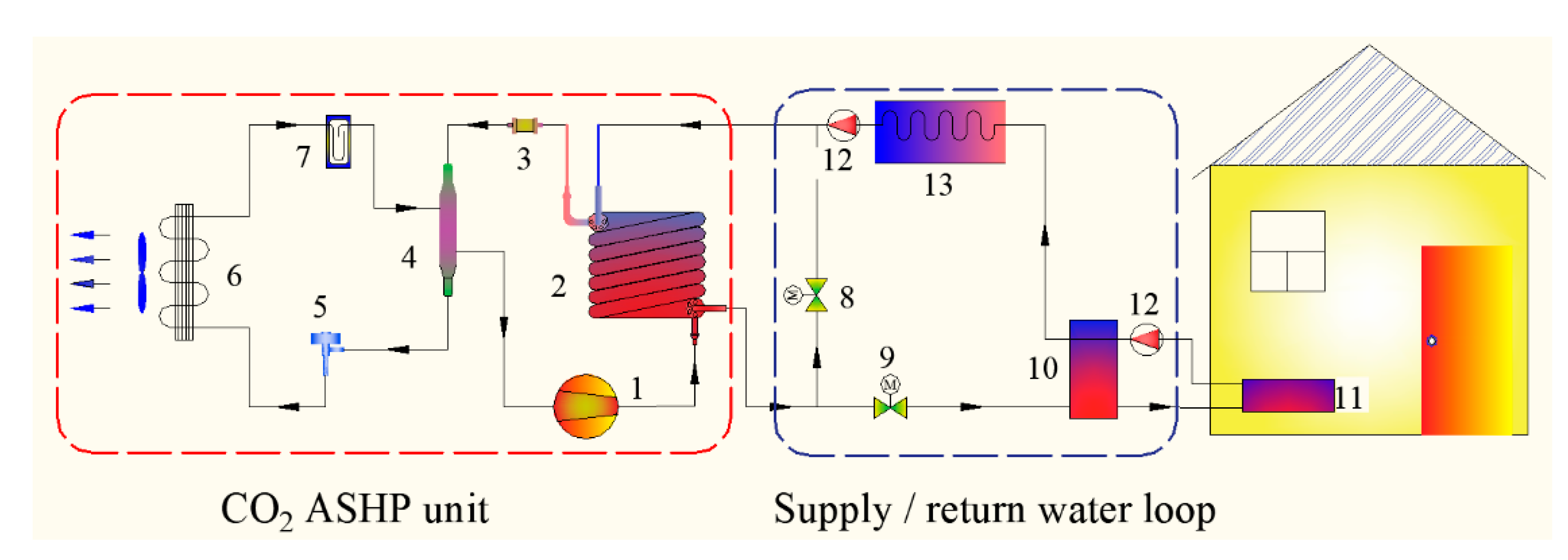

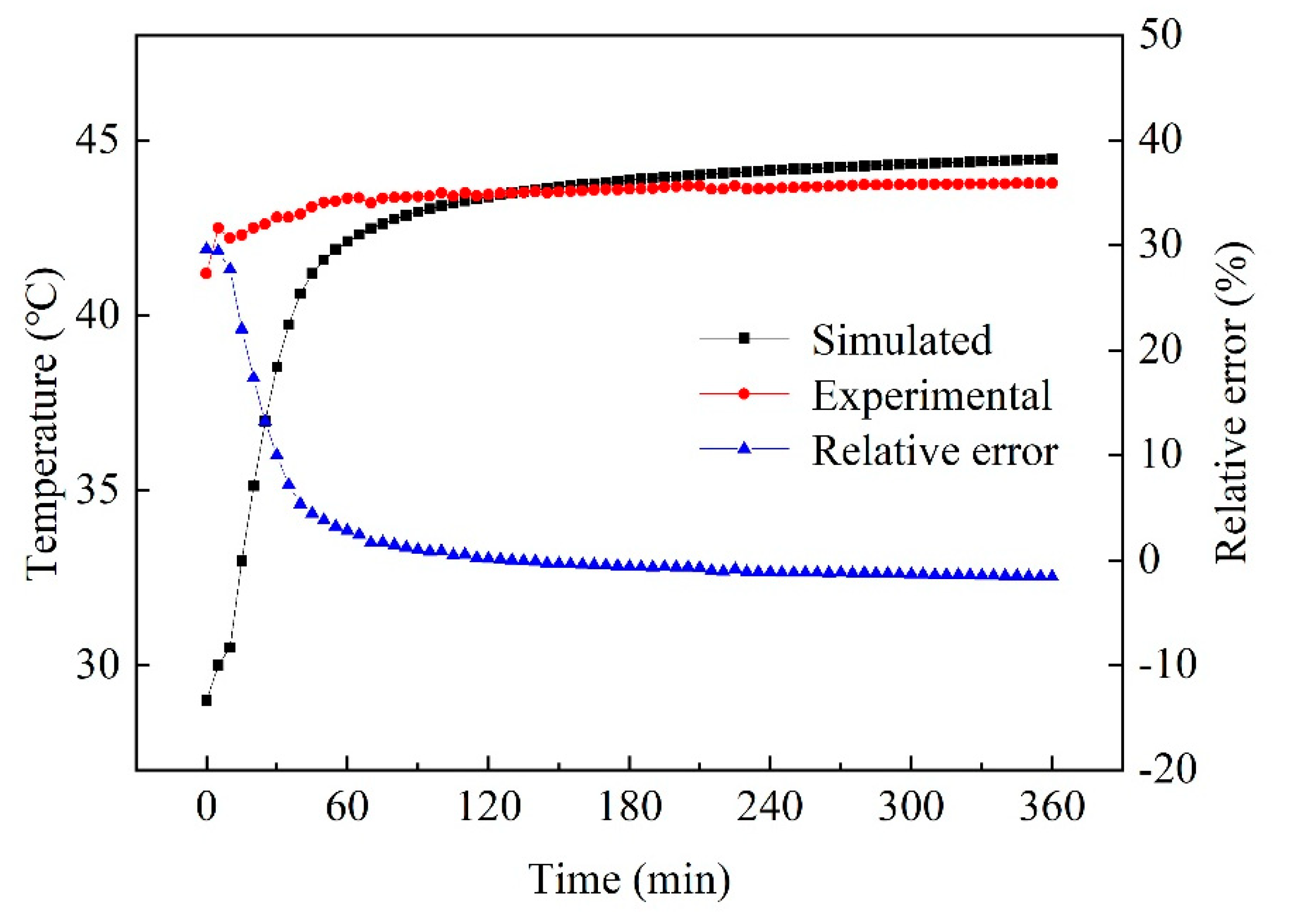
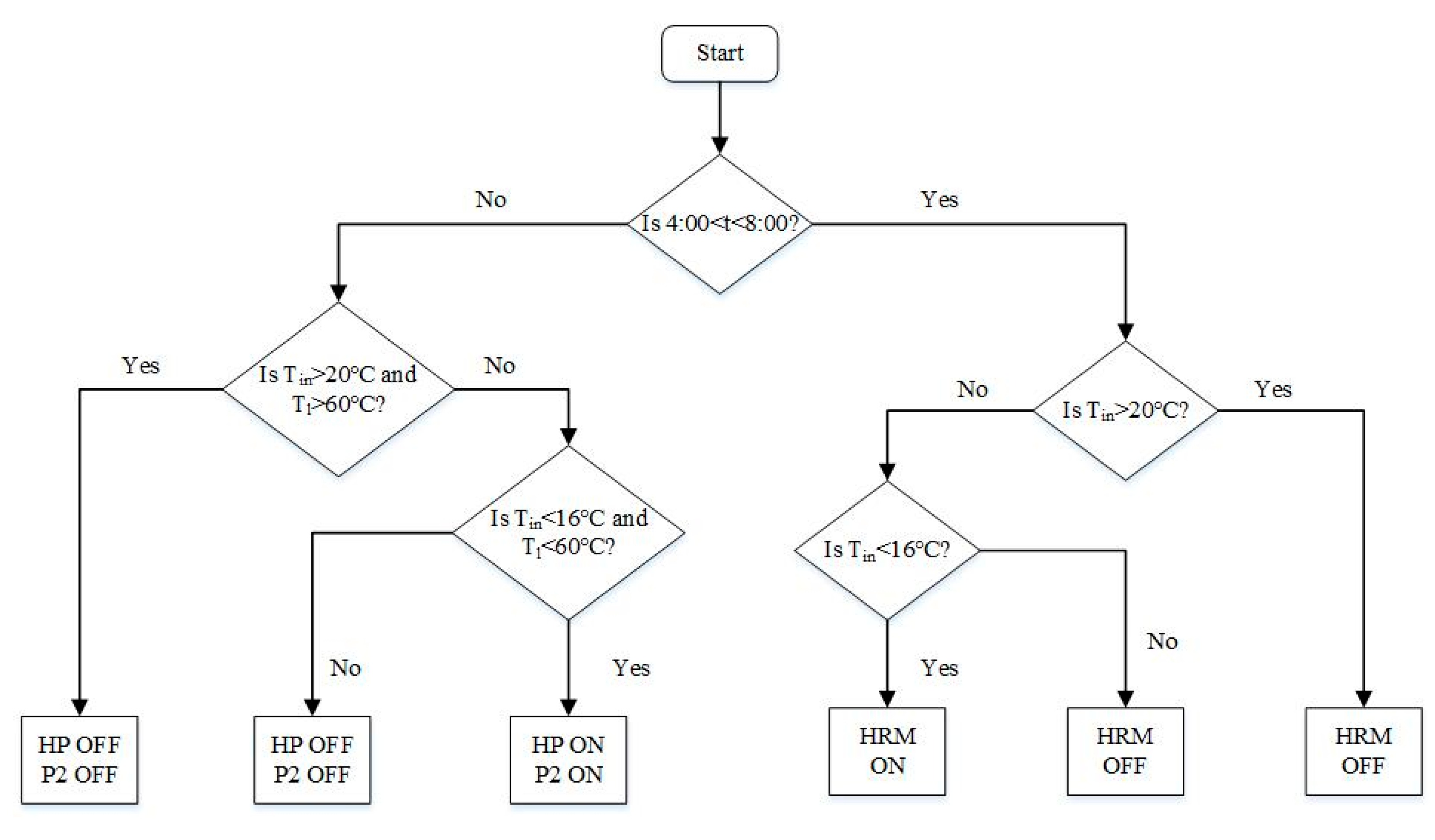


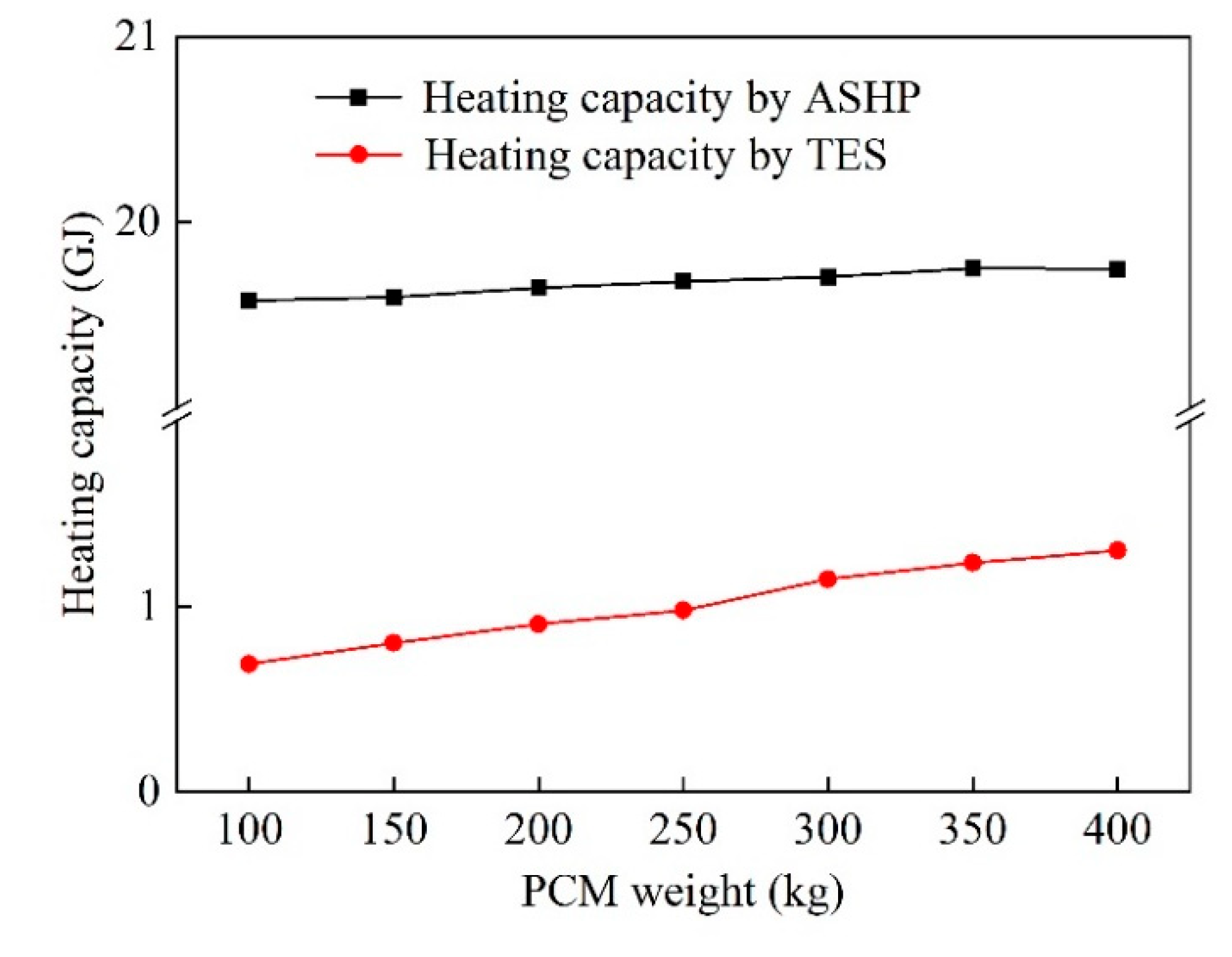
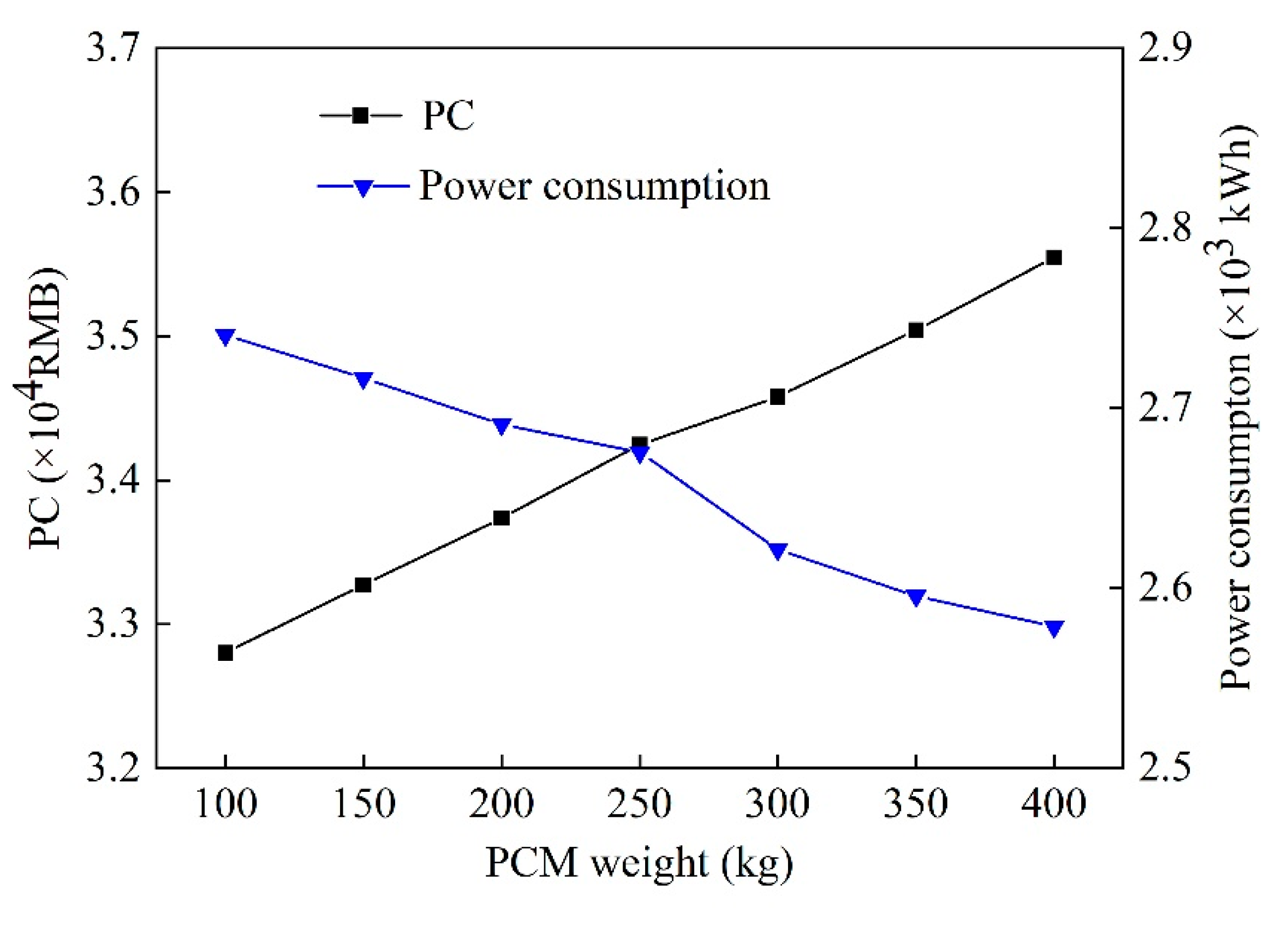
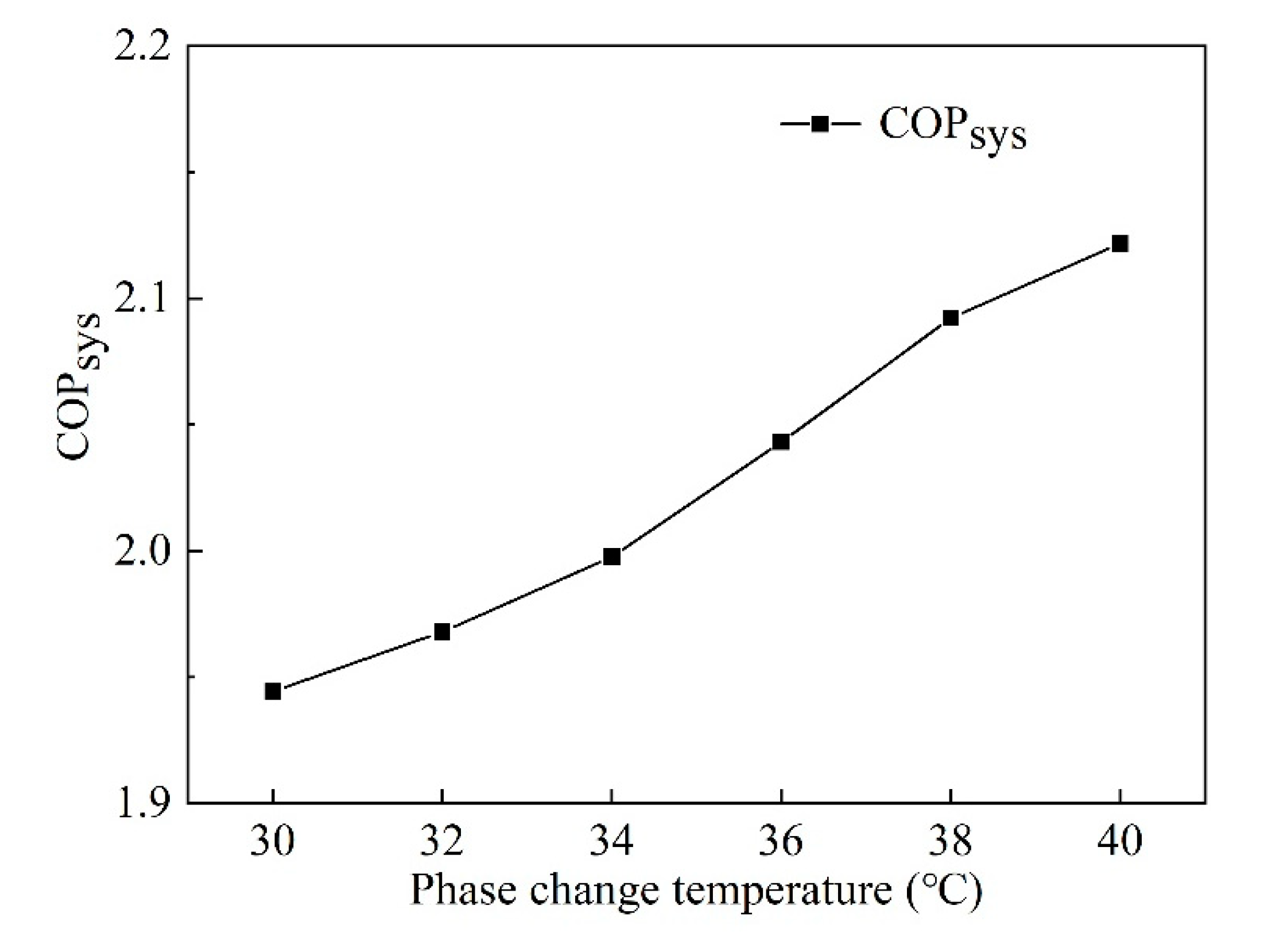

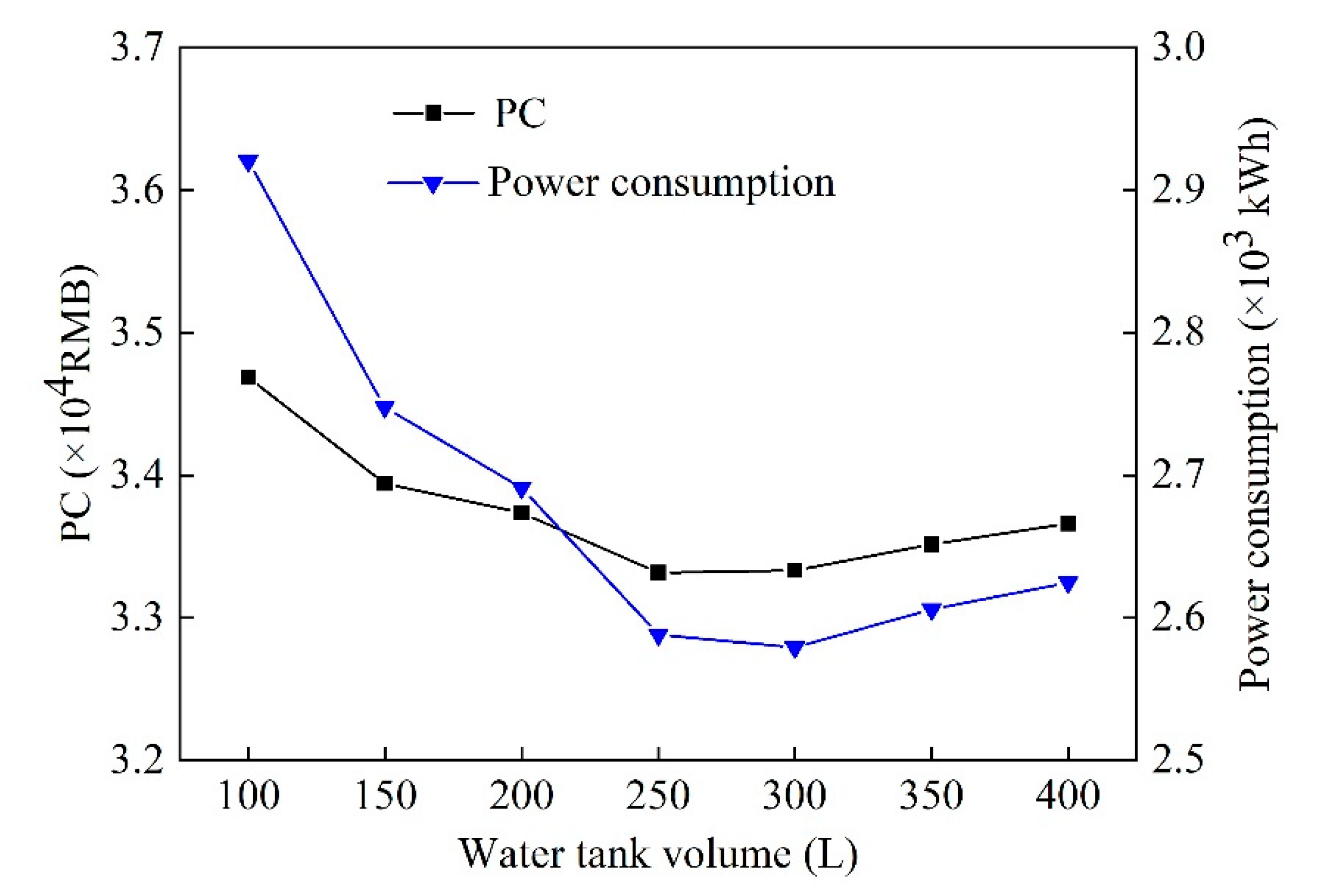
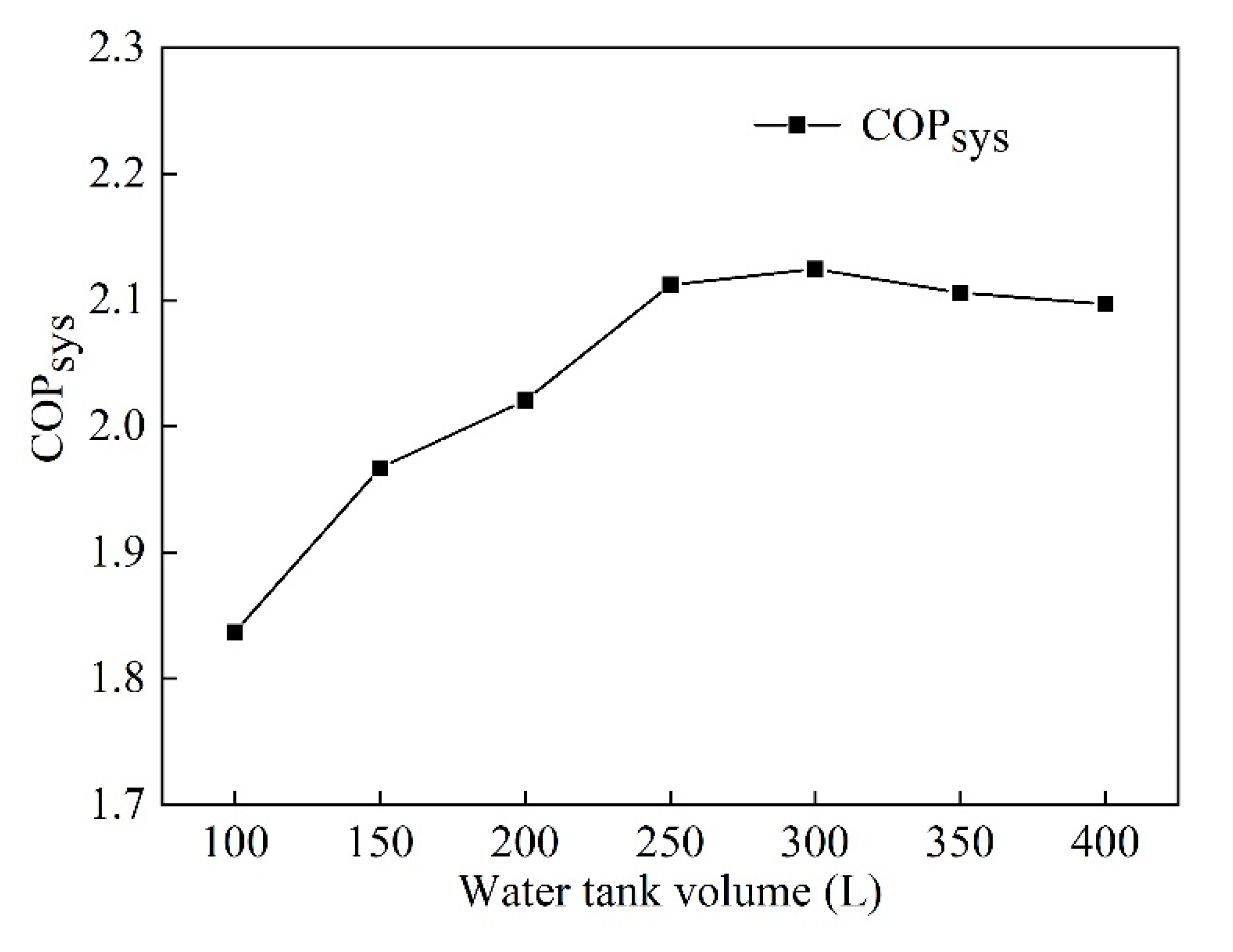
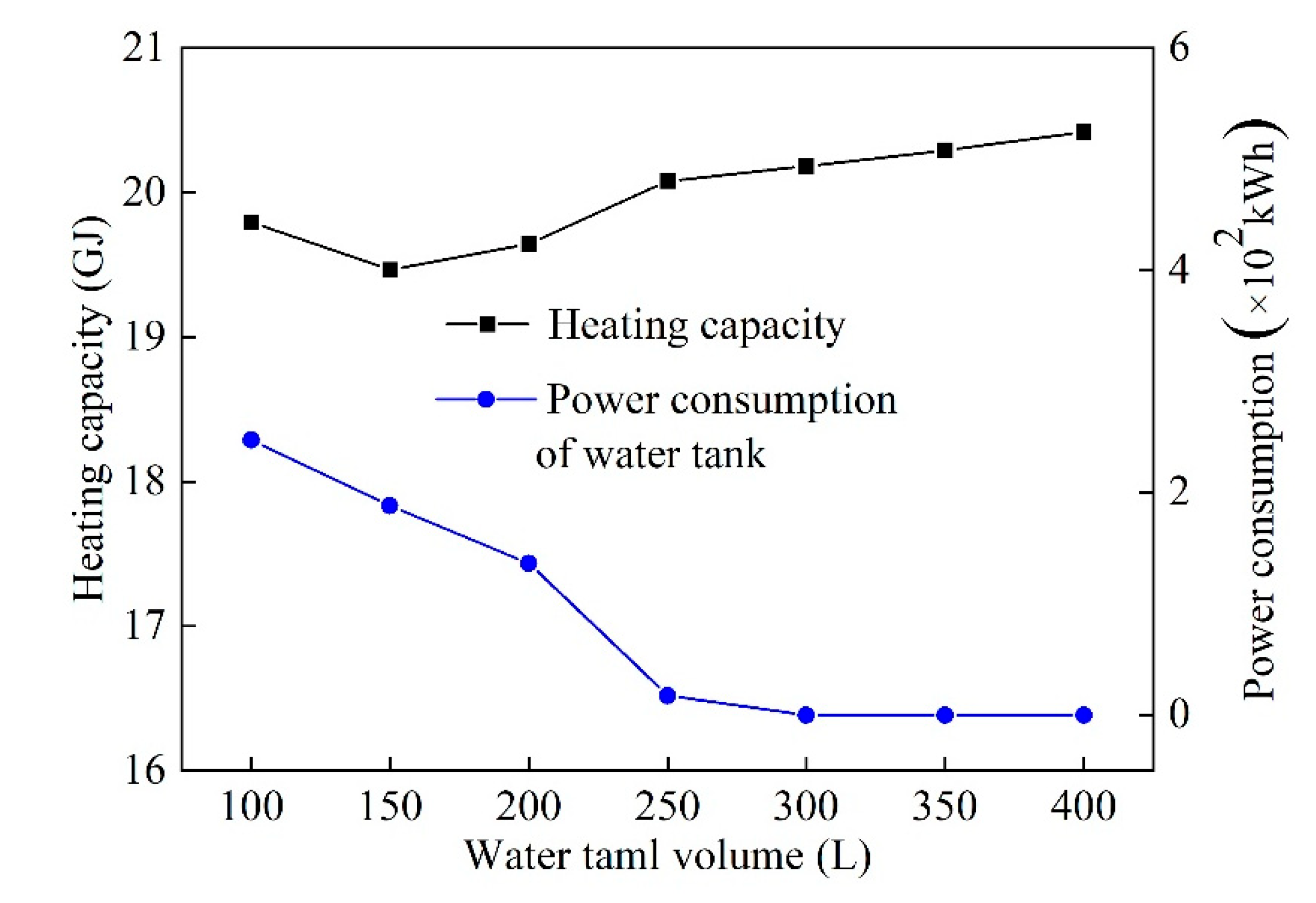

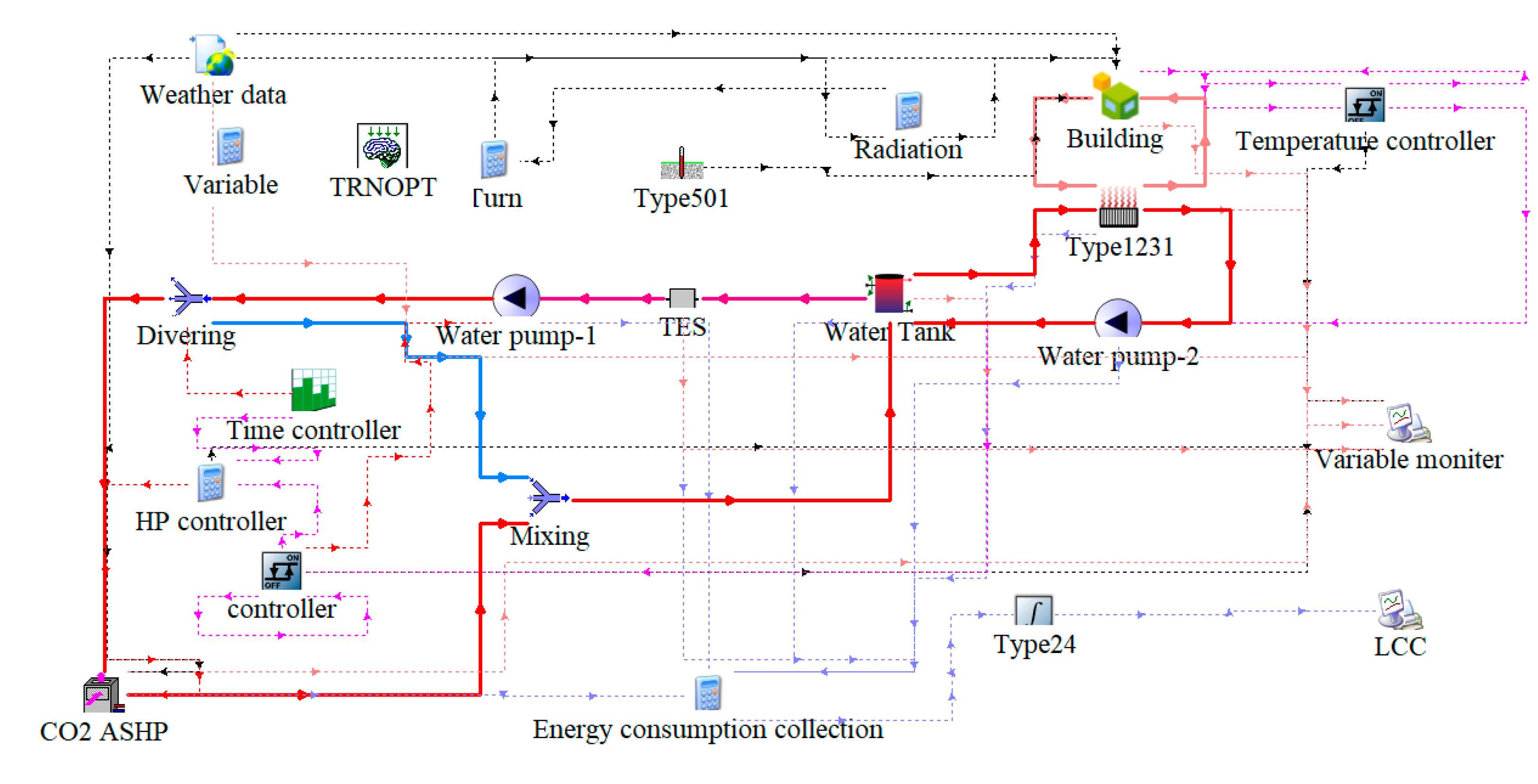
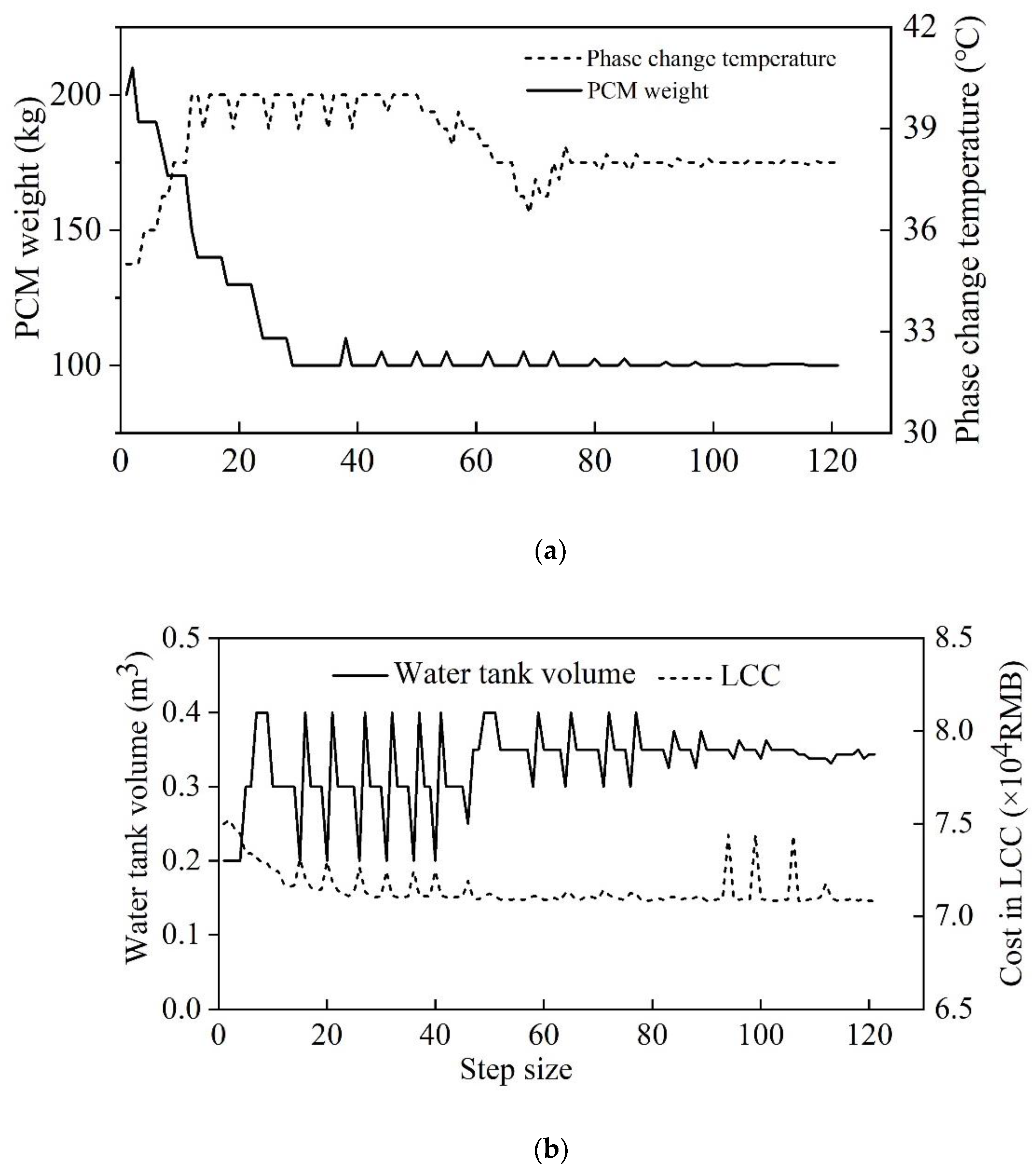
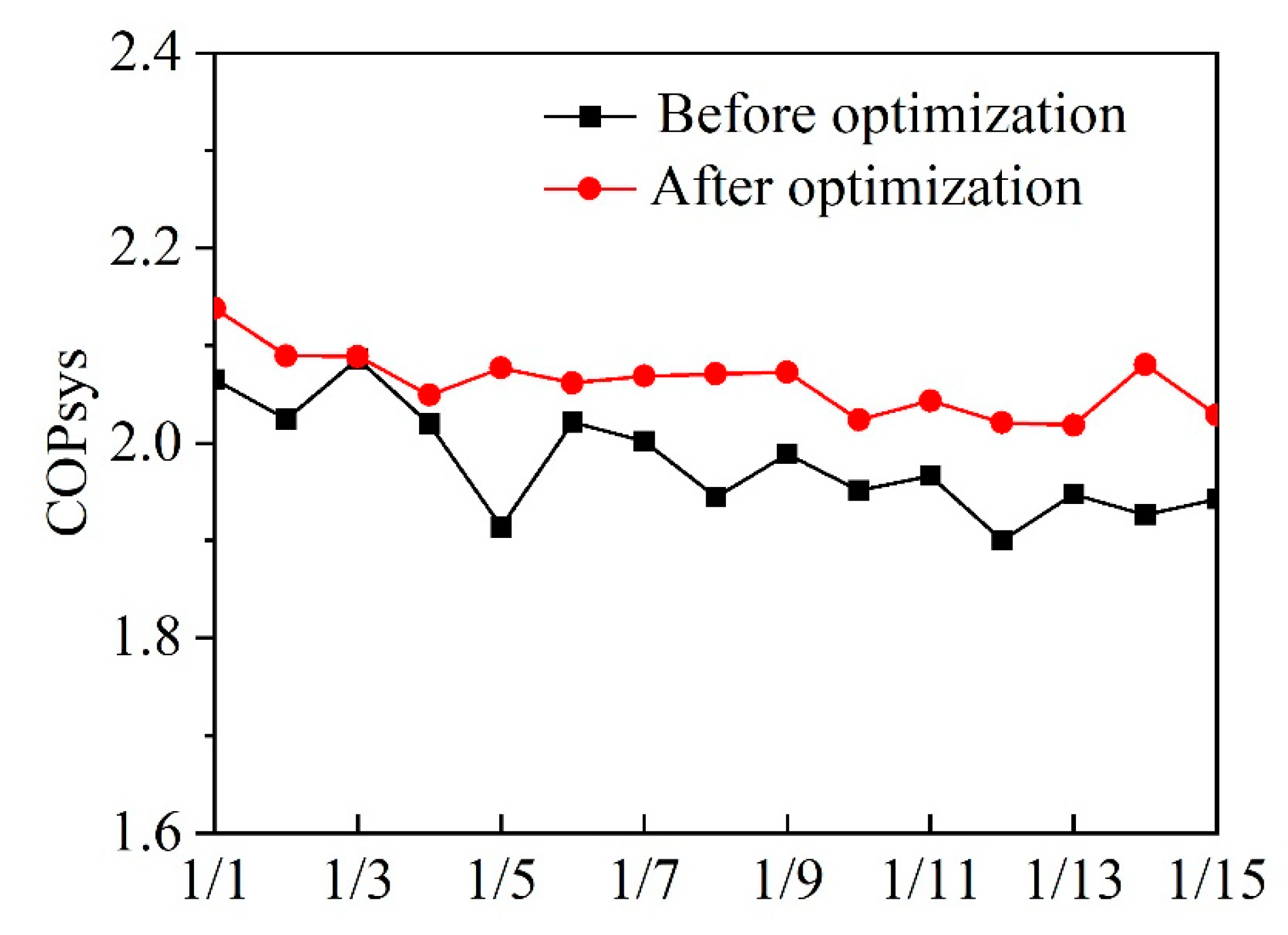
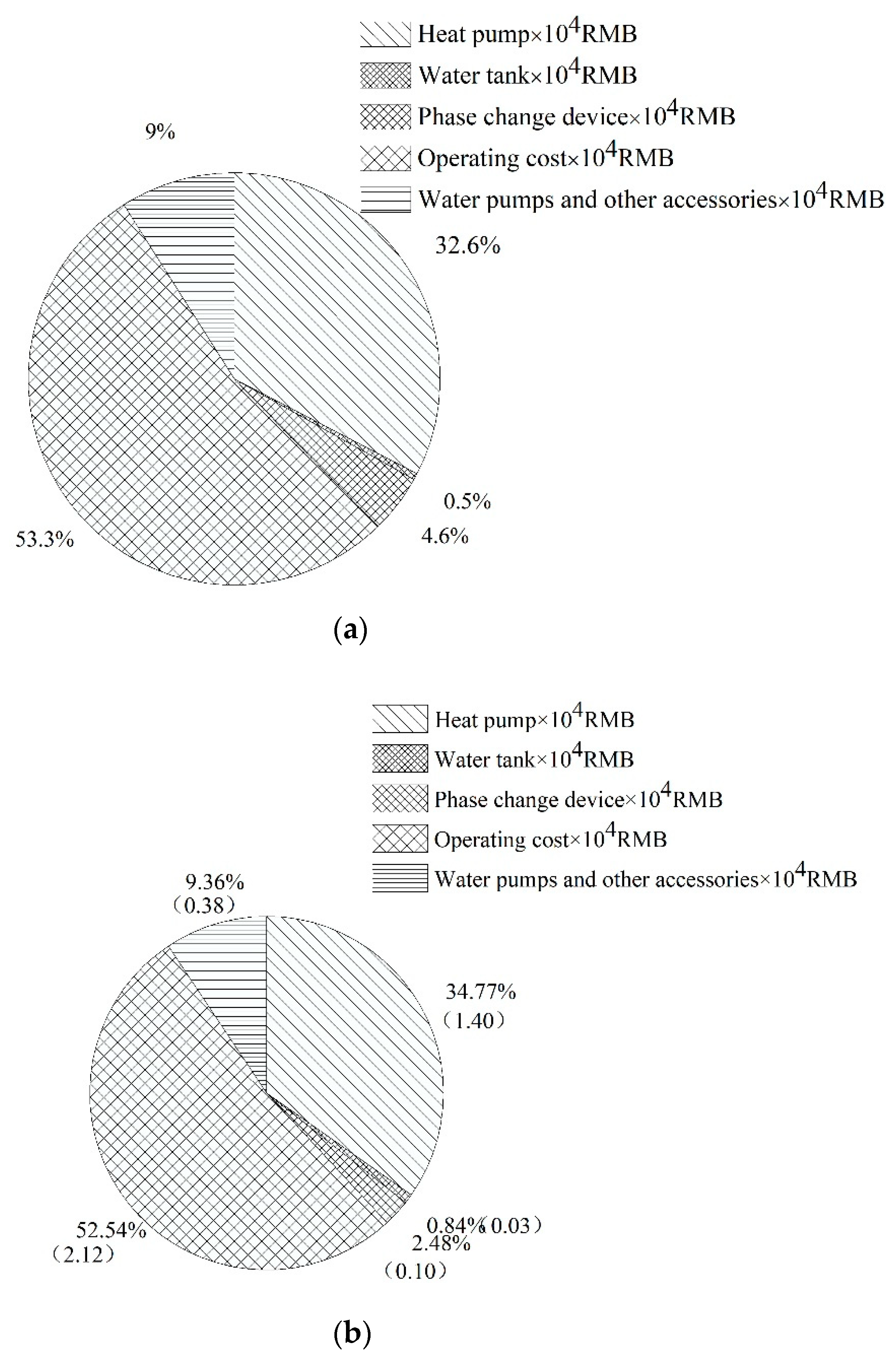
| Building Envelope | Materials and Practices | Heat Transfer Coefficient/(W/(m2·°C)) |
|---|---|---|
| Exterior wall | 20 mm cement mortar + 370 mm solid clay brick wall + 50 mm polystyrene board external insulation | 0.7 |
| Exterior door | Double glass plastic and steel frame door | 2.5 |
| Exterior window | Double glass plastic and steel frame window | 2.7 |
| Roof | Plaster roof + insulation layer | 0.8 |
| Modules | Type Part | Initial Parameter Setting |
|---|---|---|
| Building model | Type 56 | Air exchange rate: 0.5 h−1 Room temperature control range: 18 2 °C |
| Meteorological data | Type 15 | Input meteorological data of typical years in Xi’an |
| ASHP | Type 941 | Rated heat: 7 kW Rated power: 3.5 kW |
| Radiator | Type 1231 | Design heat capacity: 5 kW Design surface temperature: 50 °C |
| Buffer tank | Type 4c | Temperature stratification: 4 Volume: 0.2 m3 |
| TES | Custom | Phase transition temperature: 35 °C Material quality: 200 kg |
| Water pump | Type3d | Maximum flow: 300 kg/h Maximum power: 0.067 kW |
| Component Name | Parameters | Value | Unit |
|---|---|---|---|
| CO2 ASHP | Rated heating capacity Rated power | 7 3.5 | kW kW |
| Heat source side water pump | Flow Power | 300 0.067 | kg/h kW |
| Load side water pump | Flow Power | 300 0.067 | kg/h kW |
| TES | Weight Phase change temperature | 200 35 | kg °C |
| Buffer water tank | Volume | 0.2 | m3 |
| Variation Range | The Mass of Phase Change Heat Storage Material (m)/kg | Water Tank Volume (V)/m3 | Phase Change Temperature (t)/°C |
|---|---|---|---|
| Minimum | 200 | 0.1 | 30 |
| Maximum | 400 | 0.4 | 40 |
| Step size | 10 | 0.1 | 1 |
| Optimization Variables | Initial Value | Optimized Value |
|---|---|---|
| Weight of PCM (m)/kg | 200 | 100 |
| Water tank volume (V)/m3 | 0.2 | 0.34 |
| Phase change temperature (t)/°C | 35 | 38 |
| System Type | System Heat Supply/kWh | Total Energy Consumption/kWh | COPsys |
|---|---|---|---|
| Before optimization | 5385 | 2665 | 2.02 |
| After optimization | 5419 | 2503 | 2.17 |
Publisher’s Note: MDPI stays neutral with regard to jurisdictional claims in published maps and institutional affiliations. |
© 2021 by the authors. Licensee MDPI, Basel, Switzerland. This article is an open access article distributed under the terms and conditions of the Creative Commons Attribution (CC BY) license (https://creativecommons.org/licenses/by/4.0/).
Share and Cite
Wang, Z.; Zhang, Y.; Wang, F.; Li, G.; Xu, K. Performance Optimization and Economic Evaluation of CO2 Heat Pump Heating System Coupled with Thermal Energy Storage. Sustainability 2021, 13, 13683. https://doi.org/10.3390/su132413683
Wang Z, Zhang Y, Wang F, Li G, Xu K. Performance Optimization and Economic Evaluation of CO2 Heat Pump Heating System Coupled with Thermal Energy Storage. Sustainability. 2021; 13(24):13683. https://doi.org/10.3390/su132413683
Chicago/Turabian StyleWang, Zhihua, Yujia Zhang, Fenghao Wang, Guichen Li, and Kaiwen Xu. 2021. "Performance Optimization and Economic Evaluation of CO2 Heat Pump Heating System Coupled with Thermal Energy Storage" Sustainability 13, no. 24: 13683. https://doi.org/10.3390/su132413683
APA StyleWang, Z., Zhang, Y., Wang, F., Li, G., & Xu, K. (2021). Performance Optimization and Economic Evaluation of CO2 Heat Pump Heating System Coupled with Thermal Energy Storage. Sustainability, 13(24), 13683. https://doi.org/10.3390/su132413683







